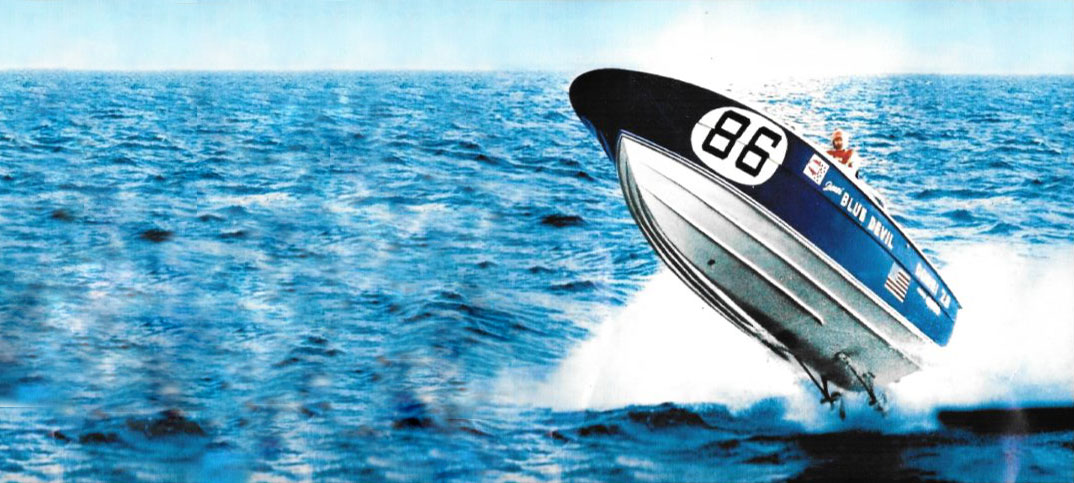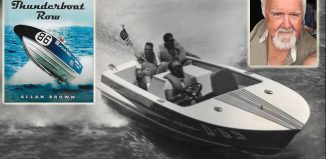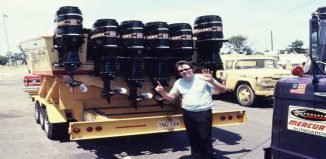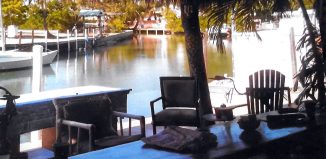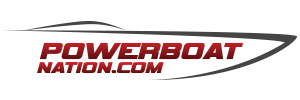After winning the Around Long Island race in 1966, I was offered the opportunity to drive a brand new 28’ Donzi that we were building at Donzi Marine, on Thunderboat Row in Miami. Our Detroit area Donzi dealer, George Couzens, had ordered the race boat to publicize his dealership in Mount Clemens, Michigan. It was to be powered by a pair of 620 HP Turbo Daytona Marine 427 c.i. Chevies, and built to a considerably lighter construction schedule than the first four 28’ Donzi race boats. Bill Wishnick owned my previous mount, “Broad Jumper”, one of the original “heavy duty” 28’ Donzi race boats built in 1964. Broad Jumper had won several races in Florida, California and New York. It had also served as a training platform for Bill (and me) to hone our racing skills. Bill was ready to go it alone, and I was ready for a faster ride.
I was a loyal (read: free engines and support) Holman Moody engine racer, and was mildly apprehensive of the powerful, but high-strung, green Daytonas (read: We had to buy them). The new boat was beautiful. It was royal blue with a white deck and bottom. It seemed natural to name it “Blue Devil”, after the #@*&^%*$ Duke University basketball team that had just cost me $300, but that’s another story. It was fast, easily 6 MPH faster than the Holman Moody powered Broad Jumper, but required meticulous throttling to keep the turbochargers turboing, and the pistons pissing.
We carried our favorite fire fighter, Mark “Big Dirty” Raymond, as mechanic, and George as navigator. Both were enthusiastic competitors, and 6’3”, 260 pounds, Big Dirty was especially handy at collecting bets, fending off jealous swains, etc. Our first race together was the 1966 Miami-Key West race. I had finished 2nd in the previous Key West race in the Broad Jumper, and looked forward to winning, as it was one of the few races that I hadn’t yet won (never did). The course was pretty simple. Start in Biscayne Bay, round Fowey Rocks Lighthouse, then keep America on your right.
Offshore racing was growing exponentially, and we had an excellent field for the race. All the local luminaries were there, Bertram, Aronow, Wynne, Genth, Merrick Lewis (Not to be confused with Odell), Langer, Raulerson, Collins, Weiler, Trotter, etc. At the starting flare, we shoved it up (you should pardon the expression) and ran away from the field, leading at Fowey light by several hundred yards.
If George was confused by the next events, one could not blame him. We rounded Fowey Light and headed for next marker, a quarter of a mile ahead of the next boat. I was driving in the center position, with George on my right, and Big Dirty on my left. George was pretty much keeping America on our right, and Big Dirty and I were in a loud discussion about something that had to do with the goings-on in the engine room. Suddenly, I pulled the throttles back, turned off both ignitions, and when the boat slowed to a stop, Big Dirty and I jumped overboard and started tearing up our natty black racing jumpsuits into shreds. What had actually happened, the bronze strut-mounted water pickups under the engines had both snapped off, and the engine room was flooding. There was no way to reach them from inside the boat, so we jumped overboard and tore strips off our clothes to plug up the holes. We discovered that if we unplugged one hole, we could idle with both engines sucking from the small lake in the bilge, and make our way back to the factory. On the way back, we took the Thunderbird/Formula race boat “Super Mother”, crewed by Californians, Peter Rothschild and Bill Cooper, in tow. The “Super Mother” 26’ boat was the latest creation that Don Aronow had stuck Merrick Lewis and Dick Genth of Thunderbird/Formula with. Like many of Aronow’s lady friends, it was really good looking, but it didn’t work. The next race for the “Devil” was a small December race from Miami to Fort Lauderdale and back a couple of times. We led to Fowey Light, which we renamed Fooey! Light, and blew a piston. John Holman offered up a shiny set of Low Riser, Weber carbureted 427 Fords, and we bit. The Fords were a little slower, but they always finished. At last, we had debugged the boat, and had aspirations of some wins. The next two races were in the Bahamas, with the 1967 Gateway Marathon from West Palm Beach to Lucaya and return, which we won, and the inaugural Bahamas 500, from Lucaya to everywhere in the Bahamas and back. The photo at the head of this story was taken from an airplane during the 500, while we were running second behind Dick Bertram. We had broken some fuel tanks, and the bilge was awash with 115/145 avgas. Not good! Big Dirty was a firefighter, and he knew what to do. He taped most of the intake grills, and made the gasoline mixture too rich to ignite, just like ‘flooding’ your car engine. We made it back to Lucaya, 45 miles, and did some serious ground-kissing.
Finally, in the summer of 1967, we arrived at the World’s Fair Marina, on Long Island. Having won the previous Around Long Island race, we were odds-on favorites to repeat, at least until we saw the entire Mercury Marine racing team show up with about thirty race boats. Mercury Racing had superior equipment, and had a support truck worthy of Indy. We had an ex-Florida Power and Light truck, with a case of free Amalie 40-weight oil. Mercury Racing had sucked up all the serious Class One racers except me, and had made all sorts of offers to power my boats as well. We nearly had a deal, but Odell Lewis refused to be my butler. The top dogs on the Mercury team were Odell and Johnny Bakos, both first class racers and first class gentlemen. Johnny Bakos had apparently drawn the short straw, and was assigned to stay with me, no matter where I went on the course.
He was driving a Donzi 008 derivative called “Sternwinder”, which was powered by the first pair of “staggered” Speedmaster drives. About 50 boats answered the starting flare. By the time we reached Coney Island, we were leading, with Bakos just behind. We zoomed past Jones inlet together, and were almost to Shinnecock inlet, when a Coast Guard chopper dropped in front of us with a sign that read: GO BACK. FOG AT MONTAUK. Dang it! Bakos had not slowed, so I didn’t either. Finally, after a couple of miles, we stopped. No one else was visible behind us as we turned and headed back. Imagine the wonder of the rest of the fleet as they saw the growing racing fleet bearing down on them from the front! We finally got them all back to the starting line. We required no repair (that we knew of), so we spent the evening drinking and lying.
The next day was a replay, with the Devil leading to Shinnecock Inlet, where we somehow lost Bakos, and we went on alone, around Montauk Point, through Plum Gut and up the smoother Long Island sound. We were conceding the race to ourselves, when Big Dirty elbowed me and pointed to the port engine’s oil pressure gauge. It was oscillating between zero and 30 or 40 pounds of oil pressure. Bad sign! The Holman Moody Fords had special 18 quart thermostatically controlled oil pans, which had, up to now, never required any thought of adding oil during a race. We slowed the port engine a bit, and got the spare case of oil from the cabin. Big dirty tore off the engine cover over that engine, poured in a couple of quarts of 40 weight oil. The pressure came up immediately. Grazia Dio! No problem. We added a couple more cans for good measure, and noted that we still had forty miles to go. In a few minutes, the oil gauge repeated the problem. We stopped for a look in the bilge. It was eerily quiet in the light fog, and we listened for other race boats, while Big Dirty assayed the situation. Apparently, after our Bahamas 500 debacle, a fiberglass repair on an engine bearer had left a solidified drop of resin in close proximity to one of the two oil filters on the port engine. We had couple of bad landings on the Atlantic side of the course, and had distorted the boat enough to punch a small hole in the oil filter. The bilge was an oily mess, and the filter was hot, at 180F. We did not carry a filter wrench, and could not turn it with a shirt wrapped around it. We started up again “as-is” and headed for the finish line at the Throg’s Neck Bridge. When the gauge hit zero, we dumped in one quart of oil, and made about a mile before it hit zero again. Quick calculation: 15 miles to go, 13 quarts of oil. Uh oh! We ran the starboard engine wide open, and the port engine at half throttle. We were still in the lead, and could see the finish line when Dick Genth caught us, and inched past in his single engine Formula. Our spirits rose when he turned the wrong way at the entrance to the East River, then sank again when he saw us turn the other way. He beat us by 10 seconds (or two quarts of oil). In two years of racing there, the total difference between first and second places was less than 20 seconds. Good racing!

